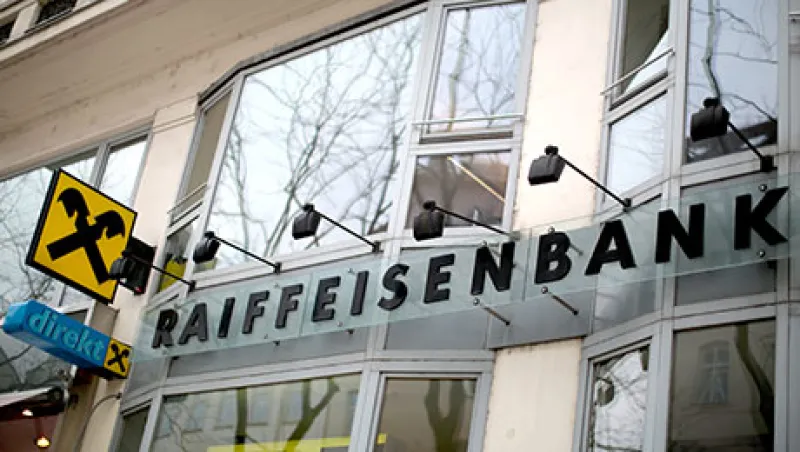Foreigners over the centuries have found it easier to enter Eastern Europe than to extricate themselves from it. Vienna–based Raiffeisen Bank International (RBI) is learning this painful historical lesson anew.
Austrian banks naturally leapt at the chance to expand eastward after the Berlin Wall and Soviet Communism fell. Erste Bank and Bank Austria (since acquired by Italy’s UniCredit) dueled Raiffeisen for market share across the former Warsaw Pact. But RBI ranged farthest and most aggressively of all, establishing itself as the largest foreign bank in both Russia and Ukraine, with the former as its top profit center.
The institution is paying a heavy price now. It posted its first annual loss ever last year: €493 million ($554 million), driven by €1.7 billion in bad-loan provisions. First-quarter 2015 earnings rebounded to €83 million; but that was down by half from a year earlier, and management has warned it might end up in the red again for the full year 2015. RBI’s shares have fallen 48 percent over the past year.
CEO Karl Sevelda announced a far-reaching downsizing plan in February that would cut risk-weighted assets in Russia by 20 percent and in Ukraine by 30 percent over three years, while the Ukraine loan book would dwindle organically toward zero. RBI decided to exit Poland altogether by selling its Raiffeisen Polbank unit. All this cutting is aimed at raising tier-1 capital from 9 to 12 percent of assets, offering investors and regulators a more compact but solid institution.
Four months later investors are waiting for concrete results, with the bank’s shares little changed since its February 10 announcement. Sevelda’s answer is that these things take time. “You can’t see or communicate any tangible results just a couple of months after the start of a project that is scheduled to go for three years,” he tells Institutional Investor.
One key plank of the restructuring, the Polish sale, is being held up by politics more than markets. RBI, seventh in Poland in terms of assets, is one of several players too small to compete in a market headed toward consolidation, Sevelda acknowledges. “This was by no means an easy decision, but Raiffeisen Polbank would need to grow significantly in order to achieve a sustainably dominant market position,” he says.
Polish authorities are opposed to acquisitions that would curtail competition, though, says Johan Ekblom, European banking analyst at Bank of America Merrill Lynch in London. President-elect Andrzej Duda, who won national elections last month, has backed a program of “repolonizing” the financial sector, an initiative discouraging bids by foreign competitors such as Italy’s UniCredit or Spain’s Banco Santander. Raiffeisen Polbank has also sustained a self-inflicted wound by issuing a high volume of Swiss franc–denominated mortgages, which seem headed for increasing default rates after the franc soared against the euro and zloty in January. RBI’s best divestment hope may lie with PZU; the Polish insurer has announced it is looking at Raiffeisen Polbank in its bid to build a banking group, but no deal is expected before late 2015 at the earliest.
Cutting back in Russia will be a slower process still. Aside from exiting marginal businesses like auto lending and shutting Raffeisen’s branch network in Russia’s far east, Sevelda offers no clear targets for the ax in President Vladimir Putin’s economically shrinking kingdom. (Russia’s gross domestic product will contract by 2.7 percent this year, then grow by 0.7 percent in 2016, the World Bank forecasts.) “Our primary goal is to increase the capital ratio,” he says. “Basically, that means that all lines of business will be reduced.”
RBI is something of a victim of its own Russian success, having built a cash cow subsidiary there while other multinationals retreated before the shadow of state-owned giants Sberbank and VTB. “RBI has a good Russian business relative to many peers,” Ekblom says.
In Ukraine, Raiffeisen failed to get out while it could. The bank was reportedly close to a sale of its Raiffeisen Bank Aval unit, Ukraine’s fourth-largest financial institution, to Russia’s Alfa-Bank in late 2013. Talks dragged on beyond the Maidan Revolution of February 2014, though, after which Alfa and other suitors lost interest. Aval booked loan losses of €254 million last year, cutting its exposure to €2.5 billion, as Ukraine lurched into war and deep recession. “At this rate, in five years they will have written off most of the business,” Ekblom comments.
The ultimate goal of RBI’s restructuring seems to resemble that of its compatriot Erste, which focused on making itself a market leader in half a dozen less volatile Central European markets rather than maintaining a presence throughout the ex-Communist world. These days, Erste is playing tortoise to Raiffeisen’s hare; its shares are up by 17 percent this year, yielding a price-to-book value above 1, whereas RBI’s languishes at about 0.5. “We expect disproportionate growth in Central Europe and some Balkan countries — for instance, Romania,” Raiffeisen’s Sevelda says.
But his bank has gone too far in Russia to credibly deemphasize it now, analyst Ekblom says. “After the restructuring they will still depend on Russia for 30 to 35 percent of net income,” he says. “To many investors that makes investment decisions difficult.”
If Russia somehow turns around, though, RBI will be positioned to spring ahead once more.
Get more on banking.






